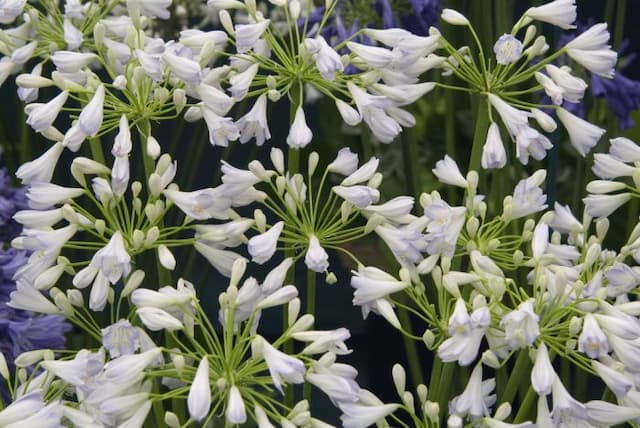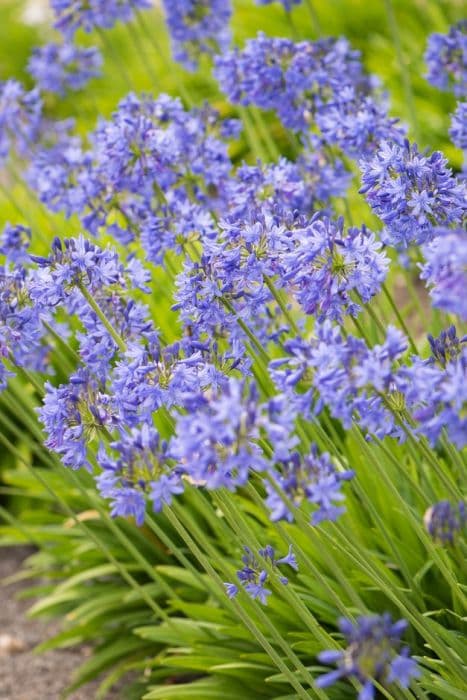African Lily Agapanthus 'Loch Hope'

ABOUT
Agapanthus 'Loch Hope' is a striking ornamental plant commonly known as Lily of the Nile, although not related to the true lilies. It is characterized by its beautiful, large clusters of bell-shaped flowers, which are typically a deep blue to violet color. These blooms are grouped tightly at the end of upright, sturdy stems that arise from clumps of strap-like, glossy green leaves. The foliage of the Lily of the Nile forms a dense, fountain-like mound, which provides a lush, green backdrop for the stunning flower heads that reach their peak during the warmer months. Each individual flower within the cluster exhibits a delicate beauty, with its trumpet-shaped form and smooth petal surfaces which may have a faint, darker stripe running through the center. The blossoms are a magnet for pollinators, such as bees and butterflies, adding another layer of liveliness to the plant's display. The Lily of the Nile is frequently chosen by gardeners for its striking appearance and the elegant touch it adds to gardens and landscapes.
About this plant
 Names
NamesFamily
Amaryllidaceae
Synonyms
African Lily, Lily of the Nile, Love Flower
Common names
Agapanthus 'Loch Hope'
 Toxicity
ToxicityTo humans
The Agapanthus, commonly known as Lily of the Nile, can be toxic if ingested. It contains several toxic compounds that can cause symptoms if parts of the plant are eaten. Symptoms of Agapanthus poisoning may include nausea, vomiting, abdominal pain, and diarrhea. In severe cases, it can also lead to dizziness or skin irritation. The sap may cause minor skin irritations upon contact. Care should be taken to avoid ingesting any part of the plant or coming into contact with the sap if you have sensitive skin.
To pets
The Agapanthus, or Lily of the Nile, is also toxic to pets, including cats and dogs. If a pet ingests parts of this plant, it can suffer from symptoms similar to those in humans. These may include vomiting, diarrhea, and nausea. In some cases, lethargy or drooling may be observed. It is important to prevent pets from chewing on any part of the plant and to seek veterinary care if they do ingest it.
 Characteristics
CharacteristicsLife cycle
Perennials
Foliage type
Evergreen
Color of leaves
Green
Flower color
Blue
Height
3 feet (90 cm)
Spread
2 feet (60 cm)
Plant type
Bulb
Hardiness zones
8
Native area
South Africa
Benefits
 General Benefits
General Benefits- Aesthetic Appeal: The Agapanthus 'Loch Hope' is known for its striking blue-violet flowers, which can add a splash of color to gardens and landscapes.
- Attracts Pollinators: These plants can attract bees and butterflies, which are beneficial for pollinating other plants in the garden.
- Drought Resistance: Once established, they have good drought tolerance, making them suitable for water-wise gardens.
- Low Maintenance: They require minimal care beyond the occasional watering and feeding, making them a good choice for low-maintenance landscaping.
- Long Blooming Period: Agapanthus 'Loch Hope' typically has a long flowering season, providing interest throughout the summer months.
- Deer Resistance: These plants are not a favored food source for deer, so they are less likely to be damaged in areas with high deer populations.
- Coastal Garden Suitability: Agapanthus is tolerant of salty air and soil conditions, making it an excellent choice for coastal gardens.
- Erosion Control: The root system of Agapanthus helps to prevent soil erosion, especially on slopes or in areas with loose soil.
- Pot and Container Growing: They can be grown in pots or containers, providing flexibility for those with limited garden space.
- Architectural Structure: With their long stems and globular blooms, they add structure and form to garden designs.
- Borders and Edging: Agapanthus can be used effectively to create defined borders or as edging plants along walkways and garden paths.
 Medical Properties
Medical PropertiesThis plant is not used for medical purposes.
 Air-purifying Qualities
Air-purifying QualitiesThis plant is not specifically known for air purifying qualities.
 Other Uses
Other Uses- Agapanthus, commonly known as African Lily, can be used in art and photography, providing a striking subject matter due to its bold blue-purple flowers and statuesque appearance.
- In culinary contexts, while not widely known for edibility, the African Lily's sturdy stems can be used creatively to fashion natural skewers for fruit kebabs in decorative displays.
- As a teaching tool in horticulture classes, the African Lily may serve as an example of bulbous plant propagation and care for students.
- In dye making, the pigments from the flowers of African Lily can occasionally be used in crafts for dyeing fabrics a soft blue color.
- The African Lily can be used as a natural pest deterrent; it’s said that planting it around the garden can deter deer and other herbivores due to its toxic properties.
- In eco-friendly landscaping, the African Lily is utilized for its drought tolerance, helping to reduce water usage in xeriscaping.
- In floristry, beyond fresh arrangements, dried seed heads of the African Lily can add an interesting texture and shape to dry floral compositions.
- Demonstrating plant geometry, the African Lily's flower structure can be used to show radial symmetry and Fibonacci sequences present in nature.
- For hand-made paper production, fibers from the stalks of the African Lily plant can potentially be included in the papermaking pulp for texture.
- In the creation of naturalistic aquariums or terrariums, while not an aquatic plant, the aesthetic of the African Lily can inspire designs and be represented with non-toxic artificial replicas.
Interesting Facts
 Feng Shui
Feng ShuiThe African Lily is not used in Feng Shui practice.
 Zodiac Sign Compitability
Zodiac Sign CompitabilityThe African Lily is not used in astrology practice.
 Plant Symbolism
Plant Symbolism- Love Letters: The genus name Agapanthus comes from the Greek words 'agape' meaning love, and 'anthos' meaning flower. The Agapanthus 'Loch Hope' may symbolize a message of love or an expression of enduring affection.
- Beauty: Known for its striking blue or purple flowers, Agapanthus is often associated with beauty and appreciation for the aesthetics.
- Strength: The Agapanthus 'Loch Hope' can also stand for strength and survival as the plant is known for its hardiness and ability to thrive in tough conditions.
- Unity: The way the flowers cluster together on top of a tall stalk can symbolize unity or togetherness, echoing the plant's ability to bring together individual blooms into a striking display.
- Prosperity: In some cultures, Agapanthus is thought to bring good fortune and welfare, hence its presence can be an emblem of prosperity.
 Water
WaterThe Lily of the Nile prefers consistent moisture, especially during the spring and summer growing seasons. Water the plant thoroughly until the water runs out of the bottom of the pot, usually amounting to about 1-1.5 gallons per week, depending on weather conditions. During the winter, reduce watering to every other week, ensuring the soil does not dry out completely. It's important to avoid waterlogging, as this can lead to root rot, so ensure adequate drainage at all times.
 Light
LightLily of the Nile thrives best in full sun to partial shade. The ideal spot for this plant is where it can receive at least 6 hours of direct sunlight daily, though it can also tolerate some light afternoon shade. Avoid placing it in deep shade as this will reduce flowering.
 Temperature
TemperatureLily of the Nile does well in a range of temperatures, from about 50 degrees Fahrenheit to 80 degrees Fahrenheit. It can survive minimal temperatures of about 20 degrees Fahrenheit but will not tolerate prolonged freezes. Ideally, keep this plant in a location where the temperature remains consistently above freezing during its growing season.
 Pruning
PruningPrune Lily of the Nile after flowering to remove spent blooms and encourage a tidy appearance. Deadheading the flowers as they fade can also promote a second bloom in some climates. Cut back foliage in late fall or early winter to prepare the plant for the next growing season. Pruning is typically done annually or as needed to maintain shape.
 Cleaning
CleaningAs needed
 Soil
SoilThe African Lily, Agapanthus 'Loch Hope,' thrives in well-draining soil that is rich in organic matter. A blend of two parts loam, one part perlite or coarse sand, and one part peat or compost is ideal. The pH should be slightly acidic to neutral, ranging from 6.0 to 7.5.
 Repotting
RepottingThe African Lily should be repotted every 2 to 3 years or when it becomes root-bound. It's best done in the spring before the growing season starts.
 Humidity & Misting
Humidity & MistingThe African Lily prefers moderate humidity levels. Humidity around 40-60% is optimal for its growth.
 Suitable locations
Suitable locationsIndoor
Place in bright indirect light and water moderately.
Outdoor
Plant in partial shade, protect from harsh winter.
Hardiness zone
8-10 USDA
 Life cycle
Life cycleThe Agapanthus 'Loch Hope', commonly known as the African Lily, begins its life cycle as a seed, sowed in well-drained soil during late winter or early spring. Germination occurs as temperatures rise, leading to the development of a small rosette of strap-shaped leaves. As the plant matures, typically over the course of a few years, it enters a vegetative stage characterized by the growth of its foliage and the enlargement of its root system. The African Lily reaches a reproductive stage in mid to late summer, producing tall flower stalks topped with clusters of bell-shaped, blue or purple flowers, which are attractive to pollinators. After pollination, seed pods form and dry out, releasing seeds which can start the cycle anew. In colder climates or during unfavorable conditions, the plant enters a dormant phase, with the foliage dying back and the plant conserving energy in its rhizomes until favorable growth conditions return.
 Propogation
PropogationPropogation time
Spring to Summer
Agapanthus 'Loch Hope', commonly known as the African Lily or Lily of the Nile, can be propagated through division, which is the most popular method. This process is ideally done in the spring or early fall when the plant is not in active bloom. To propagate by division, carefully lift the plant from the ground or container, making sure to retain as many roots as possible. Then, using a sharp knife or spade, divide the root ball into sections, ensuring that each section has at least one or two growing points. Replant these divisions at the same depth they were growing previously, spacing them about 12 to 18 inches apart (30 to 45 centimeters). Water the new plantings thoroughly to establish them, but be cautious not to overwater, as African Lilies prefer well-drained soil. This method allows the gardener to make more plants efficiently and rejuvenate older clumps that may have become too dense.









